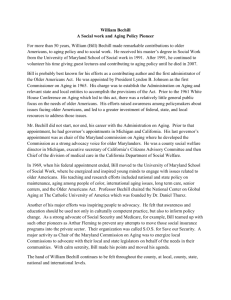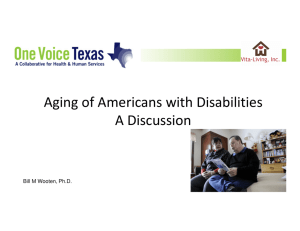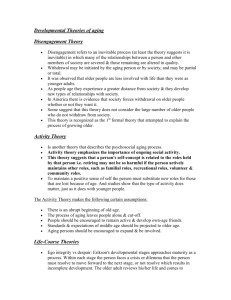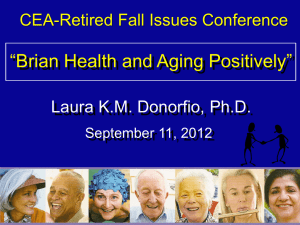Blue Yonder Airlines - MN Leadership Council on Aging
advertisement
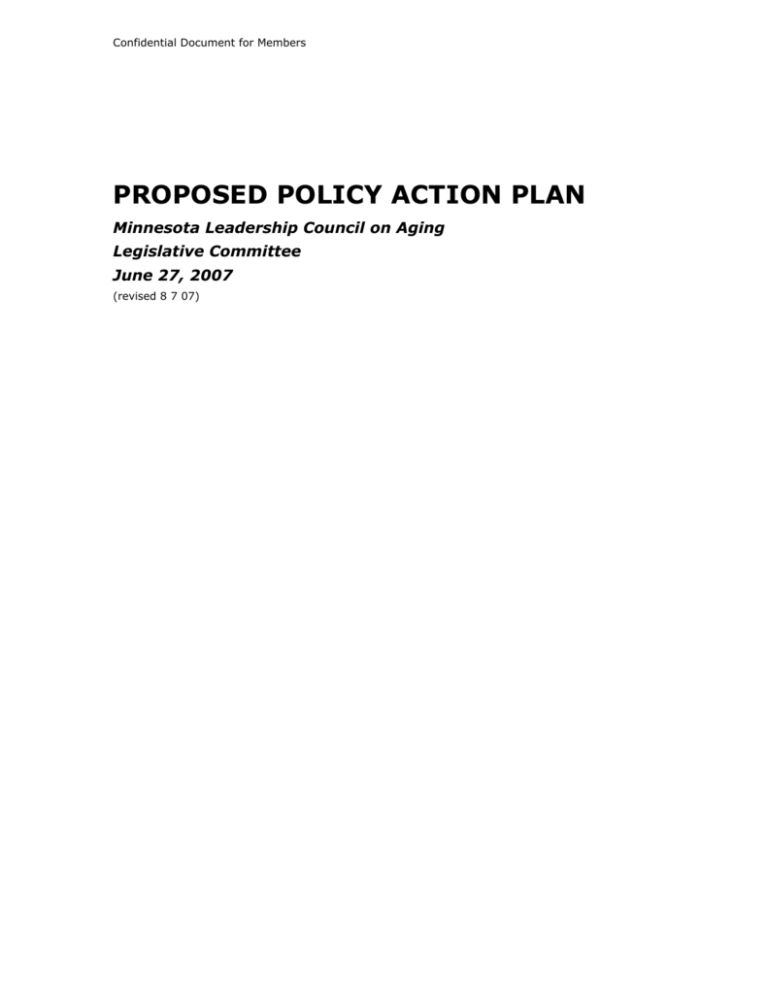
Confidential Document for Members PROPOSED POLICY ACTION PLAN Minnesota Leadership Council on Aging Legislative Committee June 27, 2007 (revised 8 7 07) LEGISLATIVE PROPOSALS TO DATE 2005 Session Blueprint to Rebalance Long-term Care HF 2203/SF 2080 Major provision Shift state and federal resources from institutional care to community care. By 2010, 60% of resources to be spent on community care of older persons Close 6,000 nursing home beds and reallocate savings to care at home Expand home and community-based services through the Waiver programs, MA homecare and Aging Grants, including an expanded Aging Grants menu Expand caregiver support via virtual, Internet-based resource center Engage local stakeholders to prioritize service expansion in their market areas Develop a relocation demonstration targeted to older persons in their first 60 days of nursing home placement Extend COLA increases across the provider community 2006 Session Long-term Care Investment Study SF 2080 (delete all amendment) Major provisions Ensure choice to meet consumer needs and preferences across service continuum; findings of study to inform Legislature to set reallocation goals and investments in core services Specific information about the needs of family caregivers of frail seniors Cost/benefit analysis of home and community-based care, including informal support Efficacy and efficiency of existing service models within varying economic, demographic and social groups at the community level Recommendations for a core set of services 2007 Session Community Care Act for Older Minnesotans HF 2178/SF 1931 Major provisions Assure access to an array of affordable home and community-based services; enact essential initial policy changes to develop a system of care grounded in the community Provide a tax credit for family caregivers of adults of all ages Develop innovative home modification, escorted transportation and evidencebased caregiver support services; implement sliding fee scales Restore funding for the Aging Grants reduced in 2003; add COLA provision Conduct studies to improve access to Waiver services, hospice care, and adult protection and elder abuse prevention services Establish a statewide priority to enhance the mobility of seniors Reduce fragmentation for seniors who need care from multiple sources through development of best practices in intake, assessment, referral and care coordination Accomplishments Council members have established the coalition’s issues and presence with legislators, the governor’s office, the MN Board on Aging, Department of Human Services, service providers and other coalitions over the three-year period. In December 2006, the Council held a successful Aging Policy Exchange, drawing 300+ persons and organizations interested in issues of aging. Warren Wolfe, Star Tribune, reported on the Policy Exchange with the headline “There’s a new voice for Minnesota’s aging population.” The Exchange affirmed consensus on three principles on which to base future policy change. During the event the Council introduced its website and list serv at www.mnlcoa.org. Ten organizations published their policy platforms on the site in the 2007 session. Each session, the Council’s bill passed the relevant policy committee, and in 2005 and 2006, passed the finance committee in at least one body. Committee hearings led to referral for possible inclusion in the Health and Human Services Omnibus Bill. The Legislature enacted some provisions of the 2007 Community Care Act – namely the extension of a COLA to the Aging Services Grants and a modest increase in base funding for nutrition and RSVP, Foster Grandparent and Senior Companion services. Other organizations were the primary advocates for these measures and the Governor’s budget included them at the outset of the session. PROPOSED POLICY ACTION PLAN 2007-2010 2007 1. Follow-up with Community Care Act authors; analyze offers to champion issues and determine next steps; conduct other follow-up as needed, including meeting with DHS Health Care Purchasing staff members to understand their position on the MSHO and EW issues raised by the Council. 2. Analyze legislative proposals from the 2007 session relevant to older persons and family caregivers; understand policy thrusts and determine if/how to connect. 3. Gather information and map systems change initiatives with community longterm care and related foci to include: DHS Quality System Architecture; Comprehensive Assessment launch and related electronic linking efforts; MBA’s Aging and Disability Resource Centers and Choices project; Transform 2010 and sub-initiatives; Community Care Act; current LTC Imperative design strategies; AARP/MHHA LTC Redesign pilot project; etc. Identify players and thinkers for future Design Teams/Stakeholder Groups to help develop 20092010 Charter. Develop document and release at January 08 Policy Exchange; publish on www.mnlcoa.org. 2 4. Analyze Community Care Act and strengthen for BIG WIN strategy in 2008. 5. Meet with Commissioner Ludeman, DHS and Governor Pawlenty to request inclusion of the refined Community Care Act in the Governor’s budget proposal. Establish relationships with Brian Osberg, Alex Bartolic and other state agency leaders. 6. Determine if MNLCOA could/should pursue change at the federal level. 2008 1. Hold 2nd Annual Aging Policy Exchange. 2. Conduct a strategic organizing campaign to assure a BIG WIN for the Community Care Act in the 2008 session. 3. Develop and conduct a multi-media campaign to raise issues of aging to be addressed by candidates in the 08 election. Use the mnlcoa list serv, radio, television and print venues featuring stories of older persons and their families. Consider the following issues and highlight solutions: a) Customized Living policy changes of 2007 session and impact on people and providers, including the unintended consequences counter to expanding non-institutional care – likely resulting in increased nursing home placement b) Access to care issues for dually eligible seniors resulting from the transition of the EW program to health plans c) Inadequacy of services for elder abuse prevention and intervention, and outdated VA Act d) Family caregiving 4. Assemble a think-tank and process to develop a vision for a comprehensive, ideal care system of the future. Become thoroughly grounded in innovation, quality, best/promising practices, consumer preferences, consumer directed care, cost containment, change initiatives in other states, and payment streams. 2009 – 2010 1. Assuming a BIG WIN in 2008, advance the vision developed in 2008 with broad elements of common ground to charter the care system of the near future. Engage broad coalition to adopt the charter and commit to its top line presentation in all discussions with policy makers, the media and other stakeholders. 3 2. Set the stage for a “Care System Omnibus Bill” fully negotiated among the community players and other stakeholders before the outset of the 20112012 legislative session. 4 Proposed Policy Action Plan (2007) July 07 August 07 Analyze meetings with September 07 October 07 November 07 December 07 Follow-up with authors, champions, opponents. legislators of the 07 session. (Dawn) John, Mike, Leni, Barb, Meet with Pam Parker to Michele F., and Dawn gain understanding of strategize for meeting with MSHO/EW issues from DHS Pam Parker, DHS on perspective. MSHO/EW issues. Analyze legislative proposals & enacted provisions of 07 session to determine common policy thrusts. (Lee) Analyze and refine Community Care Act for BIG WIN. Develop and launch a strategic organizing process to advance the Community Care Act. Strive for focused request with greatest opportunity for Develop and implement a communications plan to include grassroots advocacy and media. success. Coordinate communication and media efforts with the Network Committee. Meet with Commission Ludeman, DHS, and Governor Pawlenty. Request integration of Community Care Act in Governor’s budget. Work with Loren Coleman and Jean Wood. Establish relationships with additional, key state agency leaders (Osberg, Bartolic, others). Gather information and map systems change initiatives to feature at the 08 Aging Policy Exchange and for publication on the Web site. Table 1 – 2007 Timeline 5 Proposed Policy Action Plan (2008) Jan 08 Feb 08 March 08 April 08 May 08 June 08 July 08 Aug 08 Sept 08 Oct 08 Nov 08 Dec 08 Hold 2nd Aging Policy Exchange Implement Legislative Strategy to achieve BIG WIN with the Community Care Act. Develop media campaign to Secure media series on raise awareness of aging priority issues that may issues as election issues. include: 1) Customized Living policy change, 2) elder abuse/VA Act inadequacies, 3) issues of access to services for dually eligible older persons, 4) family caregiving Assemble think-tank. Develop vision for the future, ideal care system (Charter) and secure commitment from stakeholders to promote MNLCOA policy Charter during the 2009-2010 legislative session.1 Table 2 – 2008 Timeline 1 Consider a more assertive timeline to develop “omnibus bill” for introduction in the 2010 session for full action in 2011 budget session. 6 Proposed Policy Action Plan (2009) Jan 09 Feb 09 March 09 April 09 May 09 June 09 July 09 Aug 09 Sept 09 Oct 09 Nov 09 Dec 09 Hold 3rd Aging Policy Exchange With other stakeholders, promote the vision for the ideal care system and its charter with legislators, governor, state agencies, and others. With think-tank, design the ideal care system and implementation plan, including strategies to build a coalition with shared power across stakeholders. Determine policy and other changes needed at all levels of government and community. Table 3 – 2009 Timeline 7 Proposed Policy Action Plan (2010) Jan 10 Feb 10 March 10 April 10 May 10 June 10 July 10 Aug 10 Sept 10 Oct 10 Nov 10 Hold 4th Aging Policy Exchange Negotiate single legislative proposal among all players for 2011-2012 session to advance the ideal vision and supporting policy transformation. Table 4 – 2010 Timeline 8 Dec 10

